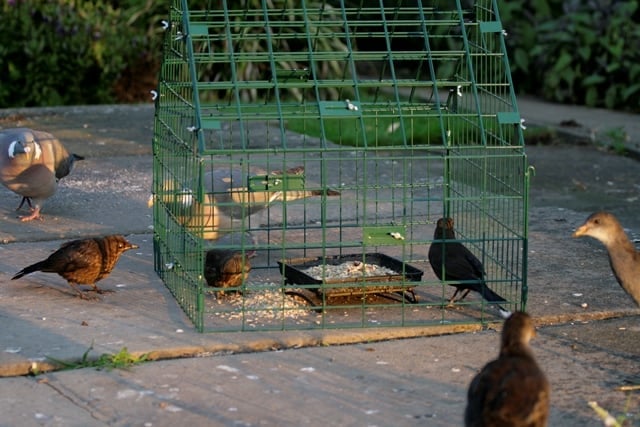How To Attract Wild Birds To Your Garden
Attracting wild birds to your garden is both hugely enjoyable and very rewarding, plus it also helps wildlife conservation and specifically helps reverse the trend of declining populations of many of our once common birds. In fact, the UK’s gardens are now considered a vital component part in a much wider conservation effort.
But why have populations of some wild birds declined so much and why are gardens now so important to them?
The songbirds we see in our gardens are typically either woodland or farmland birds – the latter having adapted to a man-made habitat over thousands of years (originally these birds would have lived on naturally open ground). But native woodland is now a relatively scarce habitat in the UK – in fact we’re one of the least wooded countries in all of Europe – and farmland has typically become a sterile habitat.
Far fewer hedgerows (which were ripped out in the 60's and 70's), very few remaining wildflower meadows, and, on most farms growing crops, a relentless policy of spraying with insecticides (insects being the main source of food for many species of birds) have all contributed to a reduction in food available for birds.
Given this backdrop, it’s easy to see why so many birds now find gardens an appealing habitat in which to both feed and nest, as in some ways it replicates their natural habitat – gardens, all with trees, from a bird’s perspective must look a lot like woodland. More open gardens with lawns, flower beds, wild areas and shrubs will appeal to birds which also favour farmland and more natural open areas of land – goldfinches for example. Plus the other obvious appeal of gardens to birds is that so many people now put out almost endless supplies of food for them.
That said, creating an optimum habitat for birds in your garden and by putting out the right foods and in the right ways, will attract far more birds and of more different species than an ‘average’ garden will with just one or two basic foods provided.
So, below we've set out some of the main things to consider, and it’s important to note that no single point will ensure you attract plenty of birds to your garden; it’s a combination of factors which all adds up:
1. Provide a wide range of different types of bird food for garden birds

Long gone are the days when all that was available to feed birds with was low-quality bird peanuts and bird seed mixes which contained all sorts of bits and pieces which birds didn't even eat.
Now there’s a wealth of different foods available, such as sunflower hearts, premium peanuts, niger seed, our high-quality bird seed mixes, suet bird food, and live foods such as live mealworms.
By providing a wide mix of bird food, you will attract more species and simply because different foods are preferred by different birds – e.g. goldfinches love niger seed, and long-tailed tits love suet blocks.
For more detailed information see our "What to Feed Wild Birds" Guide.
2. Provide a range of bird feeders and ways for birds to feed in your garden
A mix of different foods is the starting point, but if a particular bird can’t get to its favourite food then it won’t stay in your garden. A good example is a blackbird which, unlike species of tits and most finches, can’t perch on a seed feeder full of sunflower hearts.
So, even though sunflower hearts are a favourite food, the blackbird needs them in a place which is the same or similar to where it would find its natural food – such as on the ground or a bird table.
For more detailed information see our "How to Feed" Guide.
3. Provide a wildlife-friendly garden

This doesn't have to mean a wild and overgrown garden! Indeed, a well-thought-through wildlife-friendly garden can also be a relatively neat and tidy one. The key is to provide a mix of habitats – even if each is very small – and these should ideally include:
- Dense shrubs and climbers which provide cover from predators, food, roosting and nesting opportunities
- More open areas such as lawn, but consider leaving the grass longer in a few places (this actually looks really good if you make the longer grass areas into distinct shapes)
- Plants and shrubs to attract bees and other insects
- Shrubs and trees which have berries for birds to eat – for example, cotoneaster and rowan.
- Plants which have seeds birds eat – for example, sunflowers and many species of wildflower
- A bug hotel which is basically a pile of branches, twigs and other garden waste tucked in a corner of the garden somewhere – insects will live, breed and hibernate in this and provide food for your birds
- Having fresh water available for drinking and bathing – see our "Providing Water to Birds" guide for more info
- Putting up different types of nest boxes – see our nest boxes and camera boxes, plus our dedicated advice page on "Putting up Nest Boxes".
Other things to consider if you have space:
- A wildlife pond – this can be home to a huge range of wildlife and will also attract birds because of the insect food it will provide
- A dedicated wildflower area
- For larger gardens, planting native trees such as silver birch and, if your garden is really large, oak if possible
For more information about creating habitat for birds in your garden, visit our "Suitable Habitat" page.


